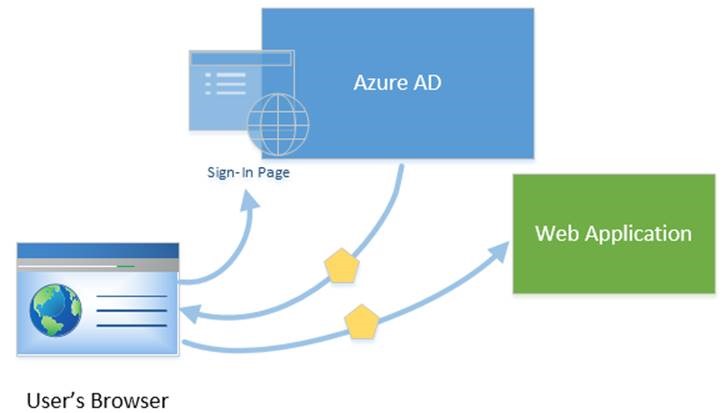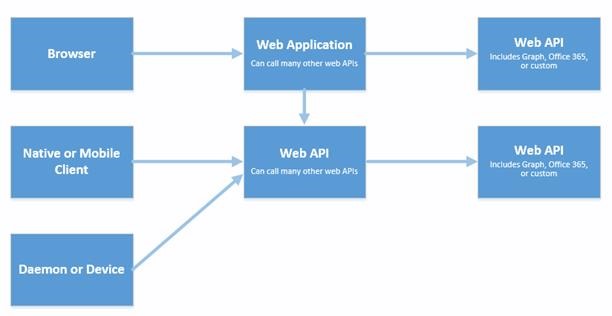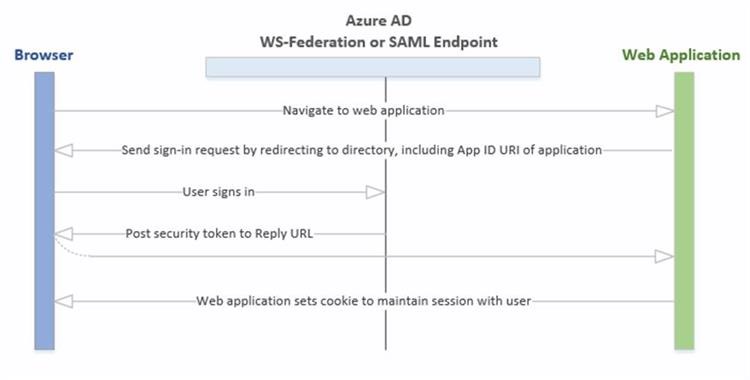Fundamentals Of Active Directory– In the Cloud (Azure Active Directory) and On-Premises (Windows Server Active Directory) and Hybrid
The cloud has changed many things, but managing identity is still key
This post should help you get started
Let's start with a bunch of links
Links to learn more
Some introductory videos
| Intro to Azure AD Premium | https://azure.microsoft.com/en-us/documentation/videos/intro-to-microsoft-azure-ad-premium/# |
| Overview of single sign-on | https://azure.microsoft.com/en-us/documentation/videos/overview-of-single-sign-on/# |
| Configure and assign groups | https://azure.microsoft.com/en-us/documentation/videos/configure-and-assign-groups-azure-ad/# |
| Cloud identity and access management infographic | https://azure.microsoft.com/en-us/documentation/infographics/cloud-identity-and-access/# |
More fundamentals
| What is Azure Active Directory? | https://azure.microsoft.com/en-us/documentation/articles/active-directory-whatis/# |
| Azure identity | https://azure.microsoft.com/en-us/documentation/articles/fundamentals-identity/# |
| Azure Active Directory Premium is now available | https://msdn.microsoft.com/en-us/library/windowsazure/dn532272.aspx# |
| Azure Active Directory applications | https://azure.microsoft.com/en-us/gallery/active-directory# |
Developer Resources
| Run Azure AD code samples | https://msdn.microsoft.com/library/windowsazure/dn646737.aspx# |
| Use scenarios to authenticate Azure AD users | https://msdn.microsoft.com/library/windowsazure/dn499820.aspx# |
| Query an Azure AD directory using the Graph API | https://msdn.microsoft.com/library/windowsazure/hh974476.aspx# |
Managing Active Directory
Application types and Scenarios
| Web Browser to Web Application | https://msdn.microsoft.com/en-us/library/azure/dn499820.aspx#BKMK_Browser |
| Native Application to Web API | https://msdn.microsoft.com/en-us/library/azure/dn499820.aspx#BKMK_Native |
| Web Application to Web API | https://msdn.microsoft.com/en-us/library/azure/dn499820.aspx#BKMK_Web |
| Daemon or Server Application to Web API | https://msdn.microsoft.com/en-us/library/azure/dn499820.aspx#BKMK_Server |
Azure Active Directory Code Samples
| Web Browser to Web Application | https://msdn.microsoft.com/en-US/library/azure/dn646737.aspx#BKMK_Browser |
| Native Application to Web API | https://msdn.microsoft.com/en-US/library/azure/dn646737.aspx#BKMK_Native |
| Web Application to Web API | https://msdn.microsoft.com/en-US/library/azure/dn646737.aspx#BKMK_AppToAPI |
| Server or Daemon Application to Web API | https://msdn.microsoft.com/en-US/library/azure/dn646737.aspx#BKMK_Daemon |
| Calling Azure AD Graph API | https://msdn.microsoft.com/en-US/library/azure/dn646737.aspx#BKMK_Graph |
| Authorization | https://msdn.microsoft.com/en-US/library/azure/dn646737.aspx#BKMK_Authz |
| Legacy Walkthroughs | https://msdn.microsoft.com/en-US/library/azure/dn646737.aspx#BKMK_Legacy |
More Samples on GitHub
| Azure Active Directory Library For Android | https://github.com/AzureAD/azure-activedirectory-library-for-android# |
| Azure Active Directory Library For Objective C | https://github.com/AzureAD/azure-activedirectory-library-for-objc# |
| Passport Azure AD | https://github.com/AzureAD/passport-azure-ad# |
| Azure Active Directory Library For Node.js | https://github.com/AzureAD/azure-activedirectory-library-for-nodejs# |
| Availability Proxy For Rest Services | https://github.com/AzureAD/availability-proxy-for-rest-services# |
Authentication scenarios
| Basics of Authentication in Azure AD | https://msdn.microsoft.com/en-us/library/azure/dn499820.aspx#BKMK_Auth |
| Basics of Registering an Application in Azure AD | https://msdn.microsoft.com/en-us/library/azure/dn499820.aspx#BKMK_Registering |
Windows Azure Active Directory Authentication Libraries
| Windows Azure AD Authentication Library for .NET | https://msdn.microsoft.com/en-us/library/azure/jj573266.aspx# |
| Windows Azure Authentication Library for Windows Store | https://msdn.microsoft.com/en-us/library/azure/dn132602.aspx# |
| Windows Azure AD Node.js Module | https://github.com/MSOpenTech/passport-azure-ad# |
Azure Active Directory Authentication Protocols
| Important Information About Signing Key Rollover in Azure AD | https://msdn.microsoft.com/en-US/library/azure/dn641920.aspx# |
| Supported Token and Claim Types | https://msdn.microsoft.com/en-US/library/azure/dn195587.aspx# |
| Federation Metadata | https://msdn.microsoft.com/en-US/library/azure/dn195592.aspx# |
| OAuth 2.0 in Azure AD | https://msdn.microsoft.com/en-US/library/azure/dn645545.aspx# |
| OpenID Connect | https://msdn.microsoft.com/en-US/library/azure/dn645541.aspx# |
| SAML Protocol Reference | https://msdn.microsoft.com/en-US/library/azure/dn195591.aspx# |
| Troubleshooting Authentication Protocols | https://msdn.microsoft.com/en-US/library/azure/dn195584.aspx# |
Integrating Applications in Azure Active Directory
| Adding, updating, and removing an application | https://msdn.microsoft.com/en-us/library/azure/dn132599.aspx# |
| Branding guidelines for integrated applications | https://msdn.microsoft.com/en-us/library/azure/dn132598.aspx# |
| Application objects and service principal objects | https://msdn.microsoft.com/en-us/library/azure/dn132633.aspx# |
Troubleshooting Azure Active Directory
| Windows Azure AD User Forum | https://go.microsoft.com/fwlink/?LinkId=320729# |
| Troubleshooting: "Active Directory" item is missing or not available | https://msdn.microsoft.com/en-us/library/azure/dn450844.aspx# |
| ACS Retry Guidelines | https://go.microsoft.com/fwlink/?LinkId=320732# |
| Troubleshooting ACS | https://go.microsoft.com/fwlink/?LinkId=320730# |
| Troubleshooting Authentication Protocols | https://msdn.microsoft.com/en-us/library/azure/dn195584.aspx# |
| Troubleshooting Azure AD Graph | https://msdn.microsoft.com/en-us/library/azure/hh974494.aspx# |
SOME BASIC FACTS ABOUT ACTIVE DIRECTORY
Because there is some confusion around Azure active directory and Windows server active directory, this next section will provide some context
It is critical to understand that there are two products in the Active Directory space :
The two products are:
- Azure Active Directory (public cloud)
- Windows Server Active Directory (In a VM in the public cloud or on-premises in a private cloud)
They are not the same
Figure 1: Azure AD and Windows Server AD
WINDOWS SERVER ACTIVE DIRECTORY
Active Directory is Microsoft's version of directory services
Directory services is a software system that stores, organizes, and provides access to information in a computer operating system 's directory.
A directory is a map between names and values. It allows the lookup of named values
Active Directory serves as a single data store for quick data access to all users and controls access to users based on the directory's security policy.
Active Directory is a directory service that authenticates and authorizes all users and computers in a Windows domain type network and in Windows Azure
- It assigns and enforces security policies
Active Directory checks the submitted password** and determines whether the user is a system administrator or normal user
What protocols does Active Directory leverage?
Active Directory makes use of Lightweight Directory Access Protocol (LDAP)** versions 2 and 3, as well as Microsoft's implementation of Kerberos and DNS
The Lightweight Directory Access Protocol is an open, vendor-neutral, industry standard application protocol for accessing and maintaining distributed directory information services over an Internet Protocol (IP) network
Kerberos is a computer network authentication protocol which works on the basis of 'tickets' to allow nodes communicating over a non-secure network to prove their identity to one another in a secure manner
- Its designers aimed it primarily at a client/server model and it provides mutual authentication for both the user and the server to verify each other's identity
The Domain Name System (DNS) is a hierarchical distributed naming system for computers, services, or any resource connected to the Internet or a private network
- It translates easily memorized domain names to the numerical IP addresses needed for the purpose of locating computer services and devices worldwide
Single Sign On (SSO) is an important capability when software runs on-premises and in the cloud
- A user logs in once and gains access to all systems without being prompted to log in again at each of them
- The real value of SSO is that a user can login once and get access to on-premises applications as well as applications running the cloud (SharePoint, Office365)
The big challenge with SSO
- The challenge is that different applications support different authentication mechanisms
- Single sign-on must internally translate and store credentials for the different applications using the original login credentials
AZURE ACTIVE DIRECTORY
Azure Active Directory is a service that provides identity and access management capabilities in the cloud
You may not put all your on-premises directory information in the cloud
- You decide who your users are, what information to keep in the cloud, who can use the information or manage it, and what applications or services are allowed to access that information
Companies can integrate their applications with Azure AD to provide single sign-on functionality for their users
- This allows applications to be hosted in the cloud and to easily authenticate users with corporate credentials
- This also allows service (SaaS) providers to make authentication easier for users in Azure AD organizations when authenticating to their services
- There is a Graph API to the directory making it possible to manage users and groups
- This makes it possible for companies and service providers to register and even brand their own applications for multi-tenant use
DEEP DIVE INTO AZURE ACTIVE DIRECTORY
Azure AD provides identity as a service
Supports OAuth 2.0 and OpenID Connect
More details can be found here
Example Scenario - End user with a browser connected to a cloud hosted web application
Figure 2: Web Browser to Web Application
Azure AD is the identity provider
Can verify identity of users and applications that exist in the company or service provider's directory
The company or service provider must register their application with Azure AD
Various authentication libraries can be used:
Windows Azure AD Authentication Library for .NET
Windows Azure Authentication Library for Windows Store
Windows Azure AD Node.js Module
- Available on GitHub
- https://github.com/AzureAD/passport-azure-ad
- Passport strategy for authenticating with Windows Azure Active Directory using SAML
Various token formats are supported:
JSON Web Tokens (JWT)
See https://msdn.microsoft.com/en-us/library/dn205065(v=vs.110).aspx for more information
Supports JWT Token in a REST Web Service
- Requests to the web service must be authenticated by Azure AD
SAML 2.0
The workflow of requests and responses for the authentication process is determined by the authentication protocol that was used, such as OAuth 2.0, OpenID Connect, WS-Federation, or SAML 2.0.
BASICS OF REGISTERING AN APPLICATION IN AZURE AD
Any application that outsources authentication to Azure AD must be registered in a directory
What a company or service provider must do in order to register with Azure AD:
Tell Azure AD about the application
- The URL where it's located
- The URL to send replies after authentication
- The URI to identify your application, and more
An application must handle the exchanging of tokens and the sign-on process
You will need to provide a unique identifier for your application
You will need to provide a reply URL or a redirect URI
For web applications
- You will need to provide a reply url, which is where the authentication response will be sent by Azure AD
- The authentication response will include token, if successful
For native applications
- You will need to provide a redirect URI, which is a unique identifier where a user agent will be sent in a OAuth 2.0 request
You will need to provide a client ID
This is automatically created by Azure AD when the application is registered
This client ID is sent along with the token during authentication
- This ID uniquely identifies your application and associates with the token
You will need to provide a key
- The key is sent with the client ID when authenticating for web applications
THERE ARE TWO TYPES OF APPLICATIONS - SINGLE TENANT AND MULTI-TENANT
Single tenant applications are used in a single organization, such as line of business applications
Multi-tenant applications support many organizations and are used primarily by software as a service companies
The application must be provisioned in each directory where it will be used, requiring an administrator to register them
Multi-tenant applications require extra work
Single tenant applications leveraging tenant specific endpoint
But multi-tenant applications are different. They will use a common endpoint that will need to identify a specific user from all the directories in Azure AD
- That endpoint is https://login.windows.net/common
It is possible to transform a single tenant application and make it multitenant capable
A single signing key can be used for all tokens in all directories, regardless of single tenant or multitenant applications
Figure Client Browser and Client Native apps accessing Cloud-based web apps: X
There are some excellent documentation and samples available at Github
Figure 4: GitHub for code
The samples include:
How to create a multitenant web applications using Open ID Connect
How to use OAuth 2.0
How to query the Azure AD using the graph API
How to authenticate with native Android and iOS applications
How to use Node.js with OAuth2
And more, including support for Java, PHP, .NET
THE FOUR KEY SCENARIOS
A browser-based client signing into a web application, secured by Azure AD
A mobile client accessing resources using a web-based API, secured by Azure AD
Browser-based client accessing resources, using a web-based API, secured by Azure AD
A demon application or server application with no user interface accessing resources, using a web-based API, secured by Azure AD
PROTOCOL FLOW DIAGRAMS FOR THE FOUR SCENARIOS ABOVE
- Can be found here, https://msdn.microsoft.com/en-us/library/azure/dn499820.aspx
KEY LEARNINGS FROM THE FOUR SCENARIOS
How the browser can access endpoints (WS-Federation or SAML)
Sign-ins getting redirected to the appropriate Azure directory
Security tokens getting posted to the Reply URL
Cookie creation to maintain session with the user
Application validation of the token (SAML, or JWT) by leveraging public signing key
A VERY COMMON SCENARIO - WEB BROWSER TO THE APPLICATION
How do you authenticate the user in a web browser to the cloud-hosted web application?
To start, the web application will need to immediately direct the browser to Azure active directory to begin the authentication process
A security token will be given to the browser so that future calls into the web application are already authenticated
This scenario supports sign-on using the WS-Federation, SAML 2.0, and OpenID Connect protocols
Figure 5: Browser to Web Scenario
Conclusion
This post should help you get started understanding Active Directory.




